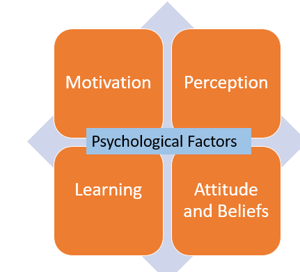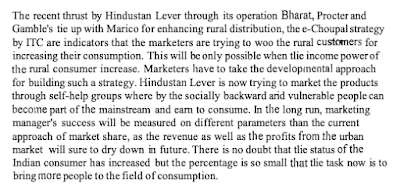Solutions to Assignments
MCO-06 - MARKETING MANAGEMENT
Master of Commerce (Mcom) 2nd Year
Question No. 5.
Comment briefly on the following statement:
(a) Different phases of development in Indian market are indicators that there is a revolution undergoing in Indian market.
(b) Marketing research is quite pervasive in nature and can be used by the marketing managers in various marketing decision areas.
Even though research is performed to generate information, but managers will not readily use the information to solve their issues. The factors that influence a manager's decision to use research output are quality of research, conformity to prior expectations, presentation clarity, political acceptability within the firm, and challenge to the status quo. But make a note that researchers and managers agree that only the technical quality of research is the key determination of research use. Also, managers are less favourable to utilize research that does not conform to prior belief or is not politically acceptable. Some researchers state that the use of information and data is a function of the direct and indirect effects of environmental, informational, organizational, and individual factors. However, a researcher should not manipulate the findings to match a manager's prior belief. Further, managers in consumer firms are less likely to utilize research findings than their peer in industrial firms. This is due to a higher exploratory objective in data gathering, a greater interest of formal organizational structure, and a lesser interest of surprise in the data gathering. Ethics defines the moral principles or values that generally regulate the conduct of an individual or group.
Researchers have roles and responsibilities to their profession, respondents, and clients, and they must stick to high ethical standards to safeguard that both the function and the data are not brought into low esteem. The Marketing Research Association, Inc. (Chicago, Illinois) has established a code of ethics that gives as a guideline for ethical decisions making in marketing. Council of American Survey Research Organization (CASRO) has a detailed policy on marketing research ethics to which its members notice. Generally, Stakeholders involved in marketing research are
- Project client who sponsors
- Supplier who designs and executes the research
- Respondent who provides the information
In practice, a marketing research goal can be coupled into three major categories programmatic, selective, and evaluative. Where, Programmatic research is conducted to determine marketing opportunities through market segmentation, opportunity analysis, and consumer attitude and product usage research. Selective research is being done to test various decision alternatives such as new product testing, advertising testing, pre-test marketing, and test marketing. Evaluative research is performed to evaluate performance of programs such as tracking advertising recall, corporate and brand image research, and customer satisfaction measurement with the quality of the product and service. As increase in number of new products and types of services, the need for marketing research become vital and the future of marketing research tends to be both promising and challenging. Marking a new product is quite difficult. Companies are relentlessly working to get fresh information that identifies and explains the needs of new consumer segments. Some companies are stick their futures on product innovations, others are revitalizing. Not only the companies that always did marketing research doing well, the size of research activities also continues to increase.
- Researchers are doing more acquisition and competitor research, segmentation and market structure analysis, and basic strategic position assessments for senior management to support for its decisions.
- Other areas, such as the legal department use marketing research. Corporate Affairs needs to know shareholders, bankers, analysts, and employees attitudes and behaviour towards the company. The service department frequently audits service delivery capability and customer satisfaction.
- Whole industries that used to be protected from the unexpected and inexplicable change in and changing customer needs. Banks, Airlines, and financial services are seeing for ways to overcome advertising clutter, product proliferation, and high marketing costs brought on by sophisticated customers and competitors.
Human psychology is a major determinant of consumer behavior. These factors are difficult to measure but are powerful enough to influence a buying decision.
Some of the important psychological factors are:

i. Motivation
When a person is motivated enough, it influences the buying behavior of the person. A person has many needs such as social needs, basic needs, security needs, esteem needs, and self-actualization needs. Out of all these needs, the basic needs and security needs take a position above all other needs. Hence basic needs and security needs have the power to motivate a consumer to buy products and services.
ii. Perception
Consumer perception is a major factor that influences consumer behavior. Customer perception is a process where a customer collects information about a product and interprets the information to make a meaningful image of a particular product.
When a customer sees advertisements, promotions, customer reviews, social media feedback, etc. relating to a product, they develop an impression about the product. Hence consumer perception becomes a great influence on the buying decision of consumers.
iii. Learning
When a person buys a product, he/she gets to learn something more about the product. Learning comes over a period of time through experience. A consumer’s learning depends on skills and knowledge. While skill can be gained through practice, knowledge can be acquired only through experience.
Learning can be either conditional or cognitive. In conditional learning the consumer is exposed to a situation repeatedly, thereby making a consumer to develop a response towards it.
Whereas in cognitive learning, the consumer will apply his knowledge and skills to find satisfaction and a solution from the product that he buys.
iv. Attitudes and Beliefs
Consumers have certain attitudes and beliefs which influence the buying decisions of a consumer. Based on this attitude, the consumer behaves in a particular way towards a product. This attitude plays a significant role in defining the brand image of a product. Hence, marketers try hard to understand the attitude of a consumer to design their marketing campaigns.
(d) Marketing of services is no different from marketing of products, the strategies of the 4 P's, however, require some modifications when applied to services.
To understand the services marketing mix framework, it’s necessary to understand the nature of services. According to Wolak, Kalaftis & Harris, the characteristics of services are:
- Intangibility–the service cannot be touched or viewed, so it is difficult for clients to tell in advance what they will be getting.
- Inseparability (simultaneity)–the service is being produced at the same time that the client is receiving it (eg during an online search, or a legal consultation).
- Heterogeneity (variability)–services involve people, and people are all different. There is a strong possibility that the same enquiry would be answered slightly differently by different people (or even by the same person at different times). It is important to minimize the differences in performance (through training, standard-setting and quality assurance).
- Perishability–unused capacity cannot be stored for future use. For example, spare seats on one airplane cannot be transferred to the next flight, and query-free times at the reference desk cannot be saved up until there is a busy period.
Each of these characteristics plays a role in the service marketing mix.
The Services Marketing Mix
Extending the 4Ps
The services marketing mix is an extension of the 4Ps framework. The essential elements of product, promotion, price and place remain but three additional elements – people, physical evidence and process are included to the 7Ps mix. The need for the extension is due to the high degree of direct contact between service providers and its customers, the highly visible nature of the service process, and the simultaneity of the production and consumption. Although it is possible to discuss people, physical evidence and process within the 4P framework (for example, people can be considered part of the product offering), this extension allows for a more thorough analysis of the marketing elements necessary for successful services marketing.
Product
In the case of services, the “product” is intangible, heterogeneous and perishable. Moreover, its production and consumption are inseparable. Hence, there is scope for customizing the offering as per customer requirements, and the actual customer encounter therefore assumes particular significance. However, too much customization would compromise the standard delivery of the service and adversely affect its quality. Therefore, particular care has to be taken in designing the service offering.
Pricing
Pricing of services is tougher than pricing of goods. While the latter can be priced easily by taking into account the raw material costs, in the case of services there are attendant costs–such as labor and overhead costs–that also need to be factored in.
A restaurant not only has to charge for the cost of the food served but also has to calculate a price for the ambiance provided.
Place
Since service delivery is concurrent with its production and cannot be stored or transported, the location of the service product assumes importance. Service providers have to give special thought as to where the service is provided. A fine dining restaurant is better located in a busy, upscale market as opposed to the outskirts of a city. A holiday resort is better situated in the countryside away from the rush and noise of a city.
Promotion
Since a service offering can be easily replicated, promotion becomes crucial in differentiating a service offering in the mind of the consumer. Service providers offering identical services such as airlines or banks and insurance companies invest heavily in advertising their services. This is crucial in attracting customers in a segment where the services providers have nearly identical offerings.
People
People are a defining factor in a service delivery process, since a service is inseparable from the person providing it. A restaurant is known as much for its food as for the service provided by its staff. The same is true of banks and department stores. Consequently, customer service training for staff has become a top priority for many organizations today.
Process
The process of service delivery is crucial since it ensures that the same standard of service is repeatedly delivered to the customers. Most companies have a service blue print which provides the details of the service delivery process, often going down to even defining the service script and the greeting phrases to be used by the service staff.
Physical Evidence
Since services are intangible in nature, most service providers strive to incorporate certain tangible elements into their offering to enhance customer experience. Many hair salons have well designed waiting areas, often with magazines and plush sofas for patrons to read and relax while they await their turn. Similarly, restaurants invest heavily in their interior design and decorations to offer a tangible and unique experience to their guests.







No comments:
Post a Comment